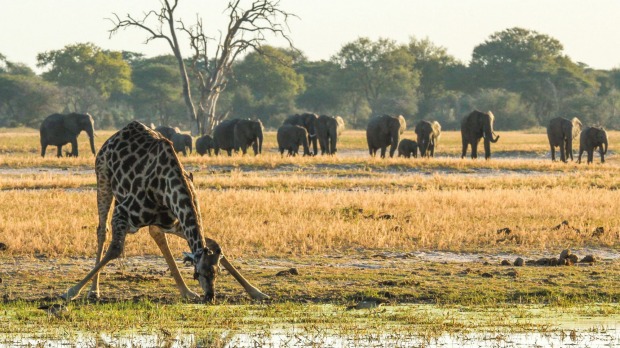
At Nehimba Lodge, there are plenty of things that go bump in the night. The boutique lodge is built around a waterhole in Hwange National Park that draws animals during the day and into the evening. Some visitors, such as warthog and antelope, come and go without too much fuss. Others tend to make an entrance.
Flapping ears, thudding feet, trumpet-like call; it is hard to hide the approach of an elephant. And Nehimba has plenty of elephants. In fact, according to the Great Elephant Census, Hwange is home to one of the world's largest pachyderm populations – about 40,000 at the latest count.
Many of them seem to enjoy hanging around Nehimba, particularly in the dry season when its waterhole is one of the few reliable water sources in the area. When the crush around the waterhole gets too great, some of them have been known to try siphoning water out of the lodge swimming pool, sometimes startling the guests who are enjoying a cool dip.
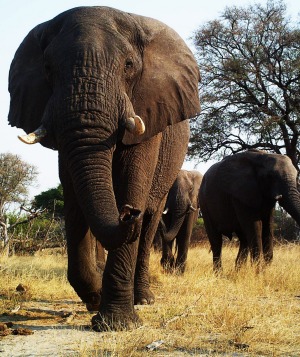
When I ask my guide precisely how many elephants show up, he tells me the number is unpredictable, then nonchalantly mentions that the record 24-hour head count is 750.
Hwange's elephants are a Zimbabwe success story. Elsewhere on the continent, poachers are decimating elephant populations. In Hwange, by contrast, numbers have boomed in the 80-odd years since the park was established, from a starting population of about 1000. Today, visitors can expect to see bachelor herds of 20 to 30 elephants, or family groups of about 40 or 50.
Unless, of course, you do as I do, and come at the wrong time. My arrival in Hwange coincides with the start of the rainy season, which is when the elephants migrate to Botswana. During my entire stay, my elephant tally never rises above three. However, they have left plenty of traces of their passing. Most of the trees stand at a uniform height, ruthlessly cropped by grazing elephants. The rest lean at precarious angles, victims of the passage of large numbers of pachyderms, which tend to move through the landscape as gently as a combine harvester. My guide shows me trees that have had their trunks worn smooth by an endless procession of tuskers rubbing their itchy bums on the bark. Even the dirt roads we drive on, he tells me, were originally trails made by elephants.
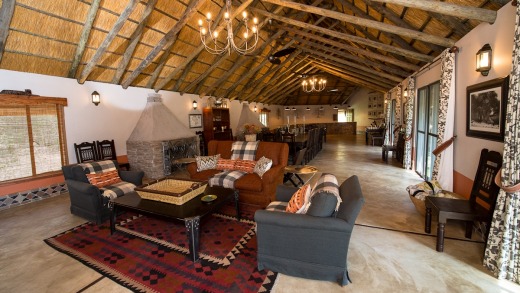
Luckily for me, elephants aren't the only impressive thing about Hwange. The park is home to 400 species of birds and more than 100 species of mammals, including leopard, hyena and wild dogs. The most staggering number of all, however, relates to visitors. At 14,650 square kilometres, Hwange is about 5000 square kilometres smaller than South Africa's famous Kruger National Park. Kruger gets about 1.6 million visitors a year. Hwange gets about 30,000.
The destruction of Zimbabwe's tourism industry is part of the broader tragedy that has enveloped the country in recent decades. A series of disasters presided over by the Mugabe government saw minorities massacred, land seized from white farmers, violent electoral protests and the economy ruined through hyperinflation. With a power-sharing government now in place, visitors are starting to come back, drawn by the prospect of superb crowd-free wildlife viewing. In the process, according to lodge co-owner Mark Butcher, they are helping rescue Zimbabwe's people from poverty. In a country where unemployment sits above 85 per cent, tourism offers desperately needed employment opportunities.
"When we were building our last lodge, we employed 83 locals during construction," Butcher says. "Sixty-three of them had never worked before. Can you imagine how they felt, able to go home to their families with money for the first time?"
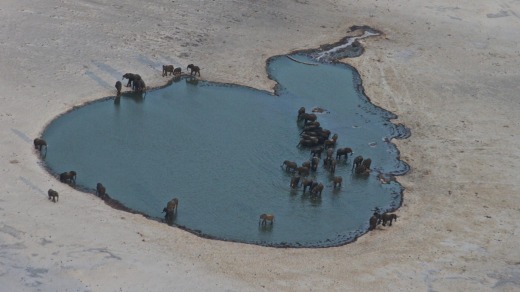
Butcher's company, Imvelo Lodges, runs six lodges, including Nehimba. Two of them – Gorges Lodge, a series of stone chalets perched dramatically 200 metres above the Zambezi River, and Zambezi Sands, a series of luxury Bedouin tents – are near Victoria Falls. Inside Hwange National Park, guests can choose between Nehimba, the tented camp at Bomani, the luxurious Camelthorn, protected by shady woodlands, and Imvelo's latest property, Jozibanini.
Imvelo works closely with communities. Camelthorn Lodge, for instance, was built not in the national park, but just outside it, on community lands. "The rents and revenues go to the local community, not to the central government," Butcher says. More importantly, a community that once lived off poaching is now able to make a living protecting animals. Imvelo works with communities in other ways, including supporting schools. Butcher says that many of Imvelo's guests are keen to find a way to contribute. One particularly enthusiastic group of dentists comes back every year to host free dental clinics for locals. "This year, they treated 2500 patients," Butcher says. "They are bloody rock stars."
I meet Butcher at Camelthorn Lodge, at the south-eastern side of the park. Our transfer from Nehimba to Camelthorn is via another of Imvelo's clever innovations: a refurbished railways car known as the Elephant Express. As we ride the rails and sip cool drinks, we spot plenty of wildlife, from jackals and giraffe to hyena and even a rare sable.
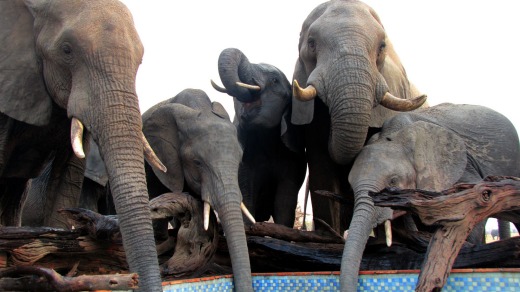
The rains have also brought an amazing influx of birdlife, from elegant crowned cranes to a range of stork species: saddlebills, redbills and marabou. I had never thought of storks as predators, but we see them wading through the small lakes that have sprung up everywhere, scooping up frogs, and standing over half-eaten wildebeest carcasses, enthusiastically tearing off strips of sinew.
Imvelo's latest camp, Jozibanini, is perched in the south-west corner of Hwange, a place largely unvisited until now. "We like to open up parts of the park that are remote and neglected," Butcher says, as another way of discouraging poachers. The landscape around Jozibanini is particularly dry; with sandy dunes and shallow valleys making for easy travel, Butcher plans to introduce another first: mountain-bike safaris.
Constructing and running the lodges is only part of Imvelo's operations; the company also pumps water to waterholes when necessary, and sets up hides by many of them, where guests can watch the comings and goings of the animals. Despite the challenges, Butcher remains enthusiastic about the future. "I have at least six places where I would like to open lodges," he says.
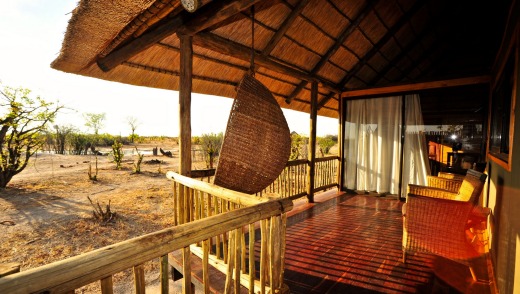
Hwange's diverse landscapes sustain a broad range of wildlife. "You never know what you will see," Butcher says. "It could be wild dogs, cheetahs, lions. We don't guarantee any sightings. If you can give a guarantee, it means you have a fence somewhere. This place is wild."
www.benchinternational.com.au
South African Airways flies daily from Perth to Johannesburg, with Virgin Australia code-share flights connecting with Sydney, Melbourne and Brisbane. SAA has daily connecting flights from Johannesburg to Victoria Falls. For more information, visit www.flysaa.com/au
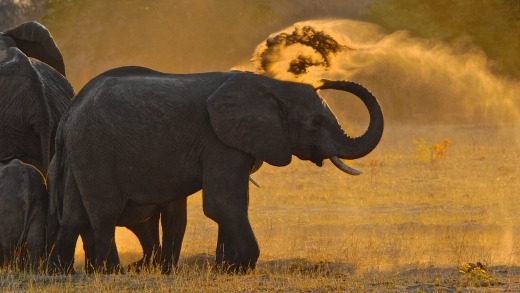
Africa experts, Bench International, offer 10-day packages from $5355 per person twin share, including accommodation, all meals, local drinks, road transfers, Elephant Express rail car, driver/guide fees, sunset cruise, guided tour of Victoria Falls, cultural village visit and laundry. For more information or to book, call 1300-AFRICA (237 422) and quote Zambezi River and Hwange Safari or visit www.benchinternational.com.au.